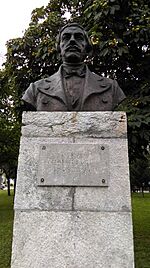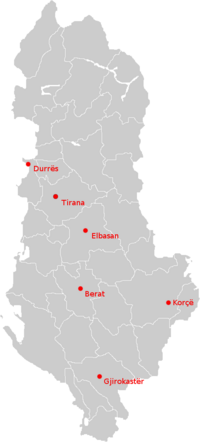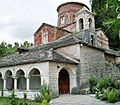Albanian Orthodox Church facts for kids
Quick facts for kids Orthodox Church of Albania |
|
|---|---|
| Autocephalous Orthodox Church of Albania Kisha Ortodokse Autoqefale e Shqipërisë |
|
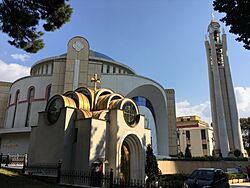
|
|
| Type | Autocephaly |
| Classification | Christian |
| Orientation | Eastern Orthodox |
| Governance | Holy Synod |
| Primate | John of Tirana-Durrës and All Albania |
| Bishops | 6 |
| Priests | 135 |
| Parishes | 911 |
| Monasteries | 150 |
| Language | Albanian |
| Liturgy | Byzantine Rite |
| Headquarters | Resurrection Cathedral, Tirana, Albania |
| Territory | Albania and Albanian diaspora |
| Founder | Bishop Theofan S. Noli |
| Independence | 11 July 1920 |
| Recognition | Autocephaly recognised in 1937 by the Ecumenical Patriarchate of Constantinople. |
| Separated from | Ecumenical Patriarchate of Constantinople |
| Members | 500,000-700,000-800,000 (claimed), number much higher when diaspora is considered. |
The Autocephalous Orthodox Church of Albania is also known as the Albanian Orthodox Church. It is an Eastern Orthodox church that runs itself. This means it is "autocephalous" (self-governing). The church declared its independence in 1922. It was officially recognized by the Patriarch of Constantinople in 1937.
The church faced many challenges during Second World War. It suffered even more during the communist period that followed. In 1967, Albania was declared an atheist state. This meant no public or private religious activities were allowed.
Since 1991, religious freedom returned to Albania. The church has grown again. More than 250 churches have been fixed or rebuilt. Over 100 new priests have been trained. The church has 909 local communities across Albania. It has about 500,000 to 550,000 followers. Some Orthodox groups say the number is as high as 700,000. This number is even higher if you include Albanians living in other countries.
History of the Church
The Christian words used in Albanian mostly come from Latin. This shows that Albanians became Christians when Latin was the main language for church services. At first, Christians in Albania were under the Pope in Rome. But from 732 AD, they came under the Patriarch of Constantinople.
In 1054, a big split happened in Christianity. It divided into two main parts: Catholicism and Orthodoxy. In Albania, this led to a Catholic north and an Orthodox south.
Orthodox Church During Ottoman Rule
The Eastern Orthodox Church was allowed to exist by the Ottoman rulers. This lasted until the late 1700s. Orthodox people in Albania were part of the Patriarchate of Constantinople. Most were under the Archbishopric of Ohrid. Some in the southwest were under the Metropolis of Ioannina.
In the late 1700s, the Orthodox Church faced problems. It was poor, and many priests could not read or write. There were not enough priests in some areas. Church services were not in Albanian. These issues made the church weaker. It became harder for Orthodox Albanians to resist changing to Islam.
By the mid-1800s, the Ottoman government made non-Muslims join the army. Because of this, many Orthodox Albanians became Muslim.
Creating an Albanian Orthodox Church
In the 1800s, Orthodox Albanians used Greek for church services and school. Many wanted to end Ottoman rule. Some wanted to join Greece. Others wanted Albania to be its own country. For Orthodox Albanians, being Albanian was often linked to being Greek because of their shared Orthodox faith. But as Albanian and Greek national movements grew, some Orthodox Albanians wanted a separate Albanian identity.
Albanian nationalism could not be based on one religion. Instead, it encouraged different religions to work together. This idea started with Naum Veqilharxhi. Even though Orthodox people were a minority, the Albanian nationalist movement began among them. It then spread to other religious groups in Albania. Orthodox Albanians, especially those living abroad, started working with Muslim Albanians for common Albanian goals. This worried Greece, which wanted to include parts of Albania.
In the early 1900s, the idea of an "Albanian Orthodoxy" grew. This was to stop Orthodox Albanians from becoming too Greek. Important Orthodox Albanians like Fan Noli joined the national movement. In 1905, priest Kristo Negovani held an Orthodox service in Albanian for the first time. He was later killed for this. In 1907, an Orthodox Albanian immigrant named Kristaq Dishnica was refused a funeral service in the United States. This was because he was involved in Albanian nationalist activities. This event, called the Hudson incident, made Albanian Orthodox people in the US decide to form their own church. They chose Fan Noli to lead it.
On March 18, 1908, Fan Noli became a priest in the United States. He held the first Orthodox service in Albanian for Albanian-Americans. Noli also worked hard to translate church services into Albanian. He became a leader for the Orthodox Albanian community in the US.
Church Independence and Rules
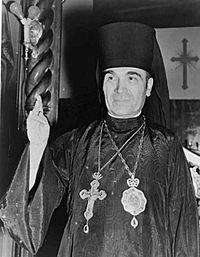
After Albania became independent in 1912, Fan Noli returned to Albania. He played a big part in setting up the Orthodox Albanian Church. On September 17, 1922, the first Orthodox meeting was held in Berat. It officially created the Albanian Orthodox Church and declared its independence. Fan Noli became the head of the church. Creating the church was seen as important for keeping Albania united. The first rules for the church were approved at this meeting.
The church made new rules in 1920 and 1923. The 1923 rules said that the head of the church must be an Albanian citizen. The Patriarchate in Constantinople officially recognized the Albanian Orthodox Church's independence in 1937.
In 1992, the rules were changed again. The part about the church head needing Albanian citizenship was removed. In 2006, new rules for the church were approved. An agreement between the church and the Albanian government was signed in 2008. This agreement became law in 2009.
Archbishops of Albania
The head of the Orthodox Autocephalous Church of Albania is called the Archbishop of Tirana and Durrës. The current archbishop is Archbishop John.
| No. | Portrait | Name | Term in office | |
|---|---|---|---|---|
| Unrecognized Independence (1919 – 1920) | ||||
| 1 |  |
Vissarion (1890–1965) |
1 March 1919 | 11 July 1920 |
| 1 year, 4 months and 10 days | ||||
| Recognized Independence (1920 –) | ||||
| 2 |  |
Christopher (1881–1958) |
11 July 1920 | 2 August 1948 |
| 28 years and 22 days | ||||
| 3 |  |
Paisius (1881–1966) |
2 August 1948 | 4 March 1966 |
| 17 years, 7 months and 2 days | ||||
| 4 |  |
Damian (1886–1973) |
7 March 1966 | 8 October 1973 |
| 7 years, 7 months and 1 day | ||||
| No Leader During Communist Era (1973 – 1992) | ||||
| 5 |  |
Anastasios (1929-2025) |
11 July 1992 | 25 January 2025 |
| 32 years, 6 months and 14 days | ||||
| 6 |  |
John (2025-) |
16 March 2025 | present |
| 9 months and 13 days | ||||
Persecution of the Church
The church suffered greatly under the rule of Enver Hoxha. All churches were controlled by the government. Land owned by religious groups was taken by the state. Teaching religion in schools was banned. Hoxha claimed that religion was a threat to Albania. In 1952, Archbishop Kristofor was found dead. Many believed he was killed.
In 1967, Hoxha closed all religious buildings in Albania. He declared Albania the world's first country with no religion. No one was allowed to practice religion, in public or private. Hundreds of religious leaders were killed or put in prison. About 600 Orthodox churches were destroyed. Other church buildings were taken over for other uses.
Revival of the Church
When communist rule ended, religious freedom returned. Only 22 Orthodox priests were still alive. To help, the Ecumenical Patriarch sent Anastasios to lead the Albanian Church. Anastasios was chosen on June 24, 1992. He officially started his role on August 2, 1992. Anastasios has earned respect for his charity work. He is now seen as an important spiritual leader for the Orthodox Church in Albania.
Many Orthodox communities have been started again in cities and villages. Church services, teaching, and religious education have grown. More people, both leaders and followers, are taking part. Groups like Orthodox Women and Orthodox Intellectuals help the church. The church's strong religious life helps Albania's society grow.
Most churches use the Albanian language for services. Greek is also used in some parts. In areas with a Greek minority, services are held in Greek.
New Clergy and Education
The church has trained many new priests. Anastasios started a seminary (a school for priests) in 1992. It moved to its own buildings in 1996. By February 2011, there were 145 priests. All of them were Albanian citizens. They graduated from the Resurrection of Christ Theological Academy. This academy also trains people for religious education and other church work.
Some students continue their religious studies at universities abroad. Two high schools for boys have also opened. They are called "Holy Cross" and are in Gjirokastër and Durrës.
New and Rebuilt Churches
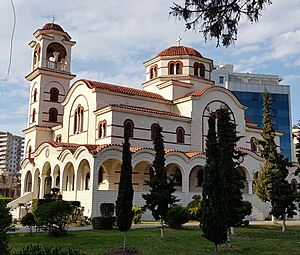
So far, 150 new churches have been built. Also, 60 monasteries and over 160 churches have been repaired. Many other buildings have been built or fixed for different uses. These include preschools, schools, youth centers, and health centers. In total, about 450 building projects have been completed.
The Orthodox Church helps Albania's economy by building and creating jobs. It is one of the biggest investors in the country. It provides work for many local builders. The church also offers courses in church building and architecture.
Media and Publishing
The Orthodox Church of Albania has its own radio station called "Ngjallja" (Resurrection). It broadcasts spiritual, musical, and educational programs 24 hours a day. It also has a special children's program.
A monthly newspaper, also called Ngjallja, is published. There is a children's magazine called Gëzohu ("Rejoice"). Other magazines include Kambanat ("Bells") for Orthodox Youth and Fjala ("Word") for students. The church also publishes news in English and other cultural and spiritual magazines.
By February 2008, more than 100 books on religious and academic topics had been published.
Social Activities
The Orthodox Church in Albania has started many social projects. It began with health care. In 1999, it opened "The Annunciation" Orthodox Diagnostic Center in Tirana. This center offers modern health services in 23 different areas. There are also four medical clinics and one mobile dental clinic. The "Service of Love" office helps train midwives and nurses.
The church gave a lot of help during Albania's political and social problems in 1992, 1994, and 1997. It collected and gave out tons of food, clothes, and medicine. It also supported many social programs. These included projects for farming in mountain areas and building roads. They also improved water supplies and offered health education for children. The church built rural health centers and helped schools, orphanages, and hospitals.
In 1999, when many refugees from Kosovo came to Albania, the church helped a lot. It worked with other groups to provide over $12 million in aid. It hosted 33,000 Kosovars in two camps. It gave them food, clothes, and medical care.
Besides the two church high schools, it has started three elementary schools. It also runs 17 day-care centers. Two professional training institutes were opened in Tirana in 2000. They teach skills like computer science and art restoration. In Gjirokastër, there is a professional school and an orphanage.
An environmental program started in 2001. An office was set up to protect Orthodox buildings that are national treasures. Choirs have been formed in churches. A Byzantine choir has also made music recordings. A workshop for restoring and painting icons was created. The church also supports academic books, films, and art exhibits.
The Orthodox Autocephalous Church of Albania takes part in events with Orthodox churches worldwide. It is a member of the Conference of the European Churches. Archbishop Anastasios has been a vice-president there. He was also chosen as one of eight presidents for the World Council of the Churches. He is an Honorary President of "Religions for Peace," a large inter-faith group. The church works for peace and cooperation in the region and beyond.
Church Leadership
The Holy Synod of Bishops was created in 1997. It is made up of:
- Archbishopric of Tirana-Durrës: Archbishop John (since 2025), who leads the Holy Synod.
- Metropolis of Korçë: vacant (as of March 2025)
- Metropolis of Berat, Vlorë and Kaninë: Asti (since 2024)
- Metropolis of Gjirokastër: vacant (as of June 2025)
- Metropolis of Elbasan, Shpat and Librazhd: Andon (since 2017)
- Metropolits of Apollonia and Fier: Nikolla of Apollonia (since 2014)
- Metropolitan of Amantia and Secretary of The Holy Synod: Nathanail (since 2017)
- Bishop of Kruja: Anastasi (since 2024)
Images for kids
-
Orthodox Cathedral in Berat on July 11, 1992
-
Church in Korçë. The Albanian Orthodox Flag Can be Seen Flown on the left Tower.
-
Orthodox cathedral in Durrës
See also
 In Spanish: Iglesia ortodoxa de Albania para niños
In Spanish: Iglesia ortodoxa de Albania para niños
- Religion in Albania
- Albanian Byzantine Catholic Church
- Christianity in Albania


